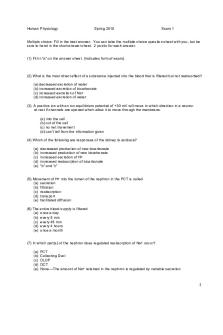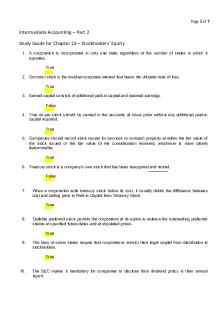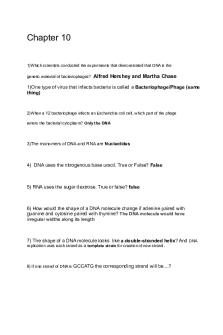Reading Guide 15 1 15 7 - exam 4 PDF

| Title | Reading Guide 15 1 15 7 - exam 4 |
|---|---|
| Course | Organic Chemistry I |
| Institution | University of Maryland Baltimore County |
| Pages | 1 |
| File Size | 56.6 KB |
| File Type | |
| Total Downloads | 82 |
| Total Views | 124 |
Summary
exam 4...
Description
Sections 15.1-15.7 Chapter 15 Skills (Learning Objectives on Blackboard): 1-9 End of Chapter Problems: 38-42, 51, 55, 57-58, 63, 65, 67-68 We will finish the semester with an introduction to spectroscopy – an important collection of tools in the identification of organic molecules. Suppose you plan a hydration of 3-methylbut-1-ene – what product do you expect? Now, how do you know if that’s what you actually get when you mix those reagents together in the lab? Molecules are too small to see, so we are left to make inferences based on whatever data we collect – for example, does the boiling point match the expected product? If yes, it might be the product (or it might be one of the many other molecules with the same boiling point!) The more data we have that matches, the more confident we are about the identity of the product. These sections describe the principles and use of infrared (IR) spectroscopy. IR spectroscopy is most useful for identifying which functional groups are present in a molecule. For example, IR spectroscopy will allow us to quickly determine whether or not an unknown compound contains an alcohol; however it will not be very useful in helping us determine which alcohol we have. The IR spectrum of a molecule contains many signals that result from the vibration of the bonds after absorbing IR radiation – different types of bonds absorb IR radiation differently and therefore have different signals. There are three important features to note for each signal: 1. What is its frequency (where is it located along the x-axis) – what determines this? [section 15.3] 2. What is its absorbance (how far does it stretch along the y-axis, how tall is it) – what determines this? [section15.4] 3. What is its shape (how broad is it?) – what factors affect this? [section 15.5] It will be important to understand both the theoretical background [section 15.2] and the practical application [sections 15.6, 15.7] of IR spectroscopy. You will not be given Table 15.2 on exams, but I will expect you to know the information contained there. We will discuss in class how to go about learning this information – you will need to memorize some numbers, but not all of them. We will focus on the trends in frequency so that you can minimize your memorization. If you are having a hard time with this reading, focus on sections 15.1-15.5 before class and go back to 15.6-15.7 after class. For these sections, I recommend the following videos: Introduction to Infrared Spectroscopy (9:24) – pairs with section 15.2 Recommended Viewing – Khan Academy There are several videos on the Khan Academy site. They are worth a look if you like to watch videos, but be aware that they tend to be more quantitative than is necessary. Office Hours Video: Analyzing an IR Spectrum (5:11) – pairs with section 15.6 Recommended Viewing - WileyPLUS This video gives a nice overview of the major regions of an IR spectrum based on the bond type....
Similar Free PDFs

Reading Guide 15 1 15 7 - exam 4
- 1 Pages

Chapter 15 Reading Guide
- 3 Pages

Chapter 15 Reading Guide
- 2 Pages

Answers- Reading 15 (TEST-1)
- 1 Pages

Exam 1 Spring 15 - fdafda
- 6 Pages

Antibiotic Pocket Guide 15
- 2 Pages

Chapter 15 - Study Guide
- 7 Pages

Chapter 7-15 questions
- 201 Pages

Exam 4 CH 10, 13-15 - Study Guide
- 12 Pages

Actividad 15 grupo 7
- 11 Pages

Exam 15 2017, questions
- 4 Pages
Popular Institutions
- Tinajero National High School - Annex
- Politeknik Caltex Riau
- Yokohama City University
- SGT University
- University of Al-Qadisiyah
- Divine Word College of Vigan
- Techniek College Rotterdam
- Universidade de Santiago
- Universiti Teknologi MARA Cawangan Johor Kampus Pasir Gudang
- Poltekkes Kemenkes Yogyakarta
- Baguio City National High School
- Colegio san marcos
- preparatoria uno
- Centro de Bachillerato Tecnológico Industrial y de Servicios No. 107
- Dalian Maritime University
- Quang Trung Secondary School
- Colegio Tecnológico en Informática
- Corporación Regional de Educación Superior
- Grupo CEDVA
- Dar Al Uloom University
- Centro de Estudios Preuniversitarios de la Universidad Nacional de Ingeniería
- 上智大学
- Aakash International School, Nuna Majara
- San Felipe Neri Catholic School
- Kang Chiao International School - New Taipei City
- Misamis Occidental National High School
- Institución Educativa Escuela Normal Juan Ladrilleros
- Kolehiyo ng Pantukan
- Batanes State College
- Instituto Continental
- Sekolah Menengah Kejuruan Kesehatan Kaltara (Tarakan)
- Colegio de La Inmaculada Concepcion - Cebu




